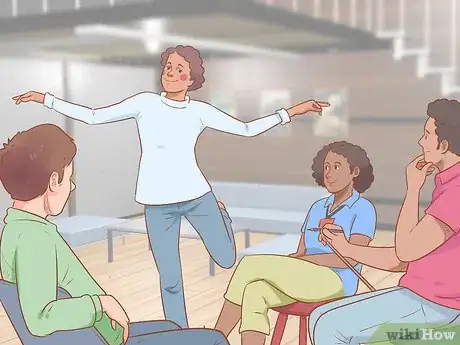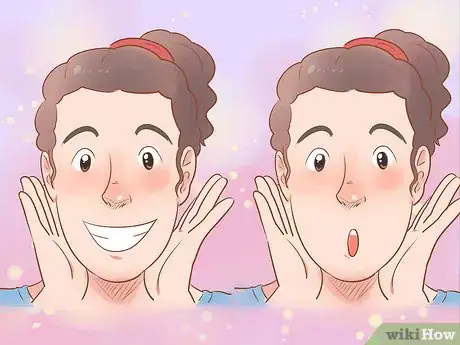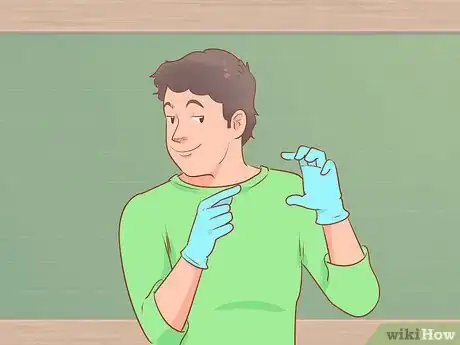This article was co-authored by Dan Klein. Dan Klein is an improvisation expert and coach who teaches at the Stanford University Department of Theater and Performance Studies as well as at Stanford's Graduate School of Business. Dan has been teaching improvisation, creativity, and storytelling to students and organizations around the world for over 20 years. Dan received his BA from Stanford University in 1991.
There are 8 references cited in this article, which can be found at the bottom of the page.
This article has been viewed 82,381 times.
Pantomime is a cool skill to learn! It’s a type of theatrical performance in which a person portrays a scene using only their body without the use of speech. Your movements and facial expressions are exaggerated to help convey the emotion of the moment. To get started as a pantomime, practice showcasing different personalities, learn how to realistically use imagined props, and work in front of a mirror to perfect your movements. It can be a really cool way to get in touch with your body and have fun at the same time![1]
Steps
Practicing by Yourself and With Others
-
1Portray different personalities to create a repertoire of characters. When you first start out in pantomime, it’s important to learn to showcase different personality traits. It’s often helpful to watch a lot of pantomimes to observe how other actors are able to express different emotions. Check out some of the more common traits that you should be able to embody:[2]
- Self-assured or confident: A self-assured person stands with their chest held high, their shoulders back, and takes firm, confident steps. They hold their head up and create space around them.
- Shy: A shy person may hunch their shoulders or look at the ground often. They may shuffle their feet when they walk or avoid making eye contact with other people.
- Smitten: A dreamy look while watching someone will convey puppy-love. A smitten person may clutch their hands together over their chest, follow behind someone closely, or swoon.
- Evil or manipulative: This person will have a conniving smile on their face and raised eyebrows. They may hunch over when they’re working on something intently, but when they move around the stage, they will appear confident.
- Bumbling or clumsy: This person may trip, run into imaginary things, and have a loping gait. They may scratch their head to show confusion, or they could pantomime that they’ve hurt themselves by falling.
-
2Practice in front of a mirror to make your movements more exact. If you’re working by yourself, use a mirror to make small modifications to make your expressions and movements more precise. Pantomime is not a subtle art, so err on the side of over-exaggeration.[3]
- You may think that your facial expressions are clear and focused, but watch yourself in the mirror to see if your transitions from one expression to the next are sudden and defined.
- This is also a good way to check that pantomiming with an invisible prop looks genuine and understandable.
- You could also have someone videotape you going through some exercises and review them later to make notes on where you could improve.
Advertisement -
3Mirror a partner to work on timing and fluidity. Sit or stand in front of another person (this works best with someone who is also interested in pantomime). Choose one person to be the leader and one to be the follower. The leader will make specific facial movements and bodily gestures, and the follower’s goal is to mimic the leader as quickly and as accurately as possible. The leader can switch from persona to persona at their discretion.[4]
- Set a timer for 3 minutes, then switch so that the leader has a chance to be the follower.
-
4Have a “pass the face” circle to practice thinking on your feet. This is an exercise that needs to be done with a group of 5 or more people. Have everyone stand in a circle and choose who will go first. That person will make a specific face to convey a particular emotion and will turn to the person on their right. That person will copy that face, but then change it to a different expression before turning to the person on their right. Continue going around the circle until it gets back to the original person.[5]
- The goal is to come up with a unique expression different from the one presented to you. It helps you think quickly and transition from moment to moment with more fluidity.
-
5Do a tug-of-war to practice realistic body movements. It helps if there are 2 or more people, but you technically could do this exercise on your own. Pretend that you are holding a thick rope and get into a squatting stance, just like you would if you were going to play an actual game of tug-of-war. Imagine what your body would look like pulled forward by excessive strength from the other side of the rope, or what it would look like as your side starts to win and pull back.[6]
- Remember to strain your muscles to give the appearance of pulling on an actual rope.
- Check your entire body as you go through this exercise: are your feet, legs, torso, shoulders, arms, and head in the right position? If you can, do this in front of a mirror to check how realistic your positions and movements look.
-
6Take a pantomime class to get more instruction on mastering the basics. Pantomime is a pretty popular sect of acting, and lots of art, drama, and community centers offer pantomime-specific classes. You’ll learn more about common movements, facial expressions, and stage presence, and you’ll get to work with other students and learn from them.
- Taking a class could also help get you into a pantomime show. Some classes end their semester by producing a short show, or you could learn more about other productions in your community that you could audition for.
Using Precise Body Language
-
1Exaggerate your movements to express a specific action. Practice doing specific things that you would do around the house, but do them in pantomime. Whatever movement you would normally make, exaggerate it to make it more visual and obvious. Try practicing a few of these actions to begin building your pantomime skills:[7]
- Opening a window or a stuck door
- Unwrapping a present
- Peeling a banana
- Buying something at a shop
- Putting on a jacket or shoes
- Cleaning
- Brushing your teeth
-
2Isolate each part of your body to make your movements more precise. Pantomime is about specific, exaggerated movements, whether or not you’re working with an imagined prop. To help yourself achieve this, examine each part of your body as you practice. From your feet to your waist to your hands and arms, each part of your body should support the scene you’re trying to portray.[8]
- Isolating each part may take a while when you first start, but over time it’ll become a habit that will help make your acting stronger.
-
3Show emotion through your facial expressions and body language. Because you don’t use words, you have to use all the non-verbals at your disposal to communicate with the audience. When you think of how your face looks in any particular emotion, multiply that expression by 5 to get what you need to communicate in pantomime.[9]
- Happiness: A wide, open smile, happy eyes, raised eyebrows.
- Surprise: An “OH” expression with your mouth, raised eyebrows, hands held up in shock.
- Sadness: A downturned smile, a head that tilts to the side or hung low, sorrowful eyes.
- Anger: A tight face, muscles taut, quick, fast body movements.
-
4Visualize what you are going to do when you’re working with a prop. When you work with an imaginary prop, think through what your movements should look like before you actually start acting. Where will you pick up the item from? How heavy or how light will it be in your hands? Where will you make the space to complete whatever action you’ll be doing?[10]
- For example, if you’re a server at a restaurant and will be pantomiming grinding pepper onto a guest’s plate, where is the grinder coming from? Do you pick it up from the table or was it tucked into your apron? Will you need to bend at the waist to reach the guest’s plate? What hand movements will you use to show what is happening? Visualizing this beforehand helps you prepare better for the actual action.
-
5Imagine the prop in different spaces to make it more real. The goal with visualizing and imagining this imaginary prop in different spaces is to make it more physical in your mind, which will help you give a more realistic presentation. For example, if your prop is an apple, what would it look like to pick it up from a fruit bowl? What if you were to cut it into pieces on the counter? Perhaps it was in a purse or backpack and you need to pull it out.[11]
- Remember that any item, no matter how small, takes up space. Visualizing the object in different places can help make it more real in your mind.
-
6Interact with the “object” in different ways to get your technique down. This is something you can do throughout the day, even when you aren’t at practice. For example, if you’re putting on a jacket in a scene, what does it look like to fold that jacket or to hang it up on a peg? What about shaking it out or reaching into its pockets? The more you interact with the object, the more realistic your scene will be.[12]
- Use the physical object in front of a mirror if you're having trouble imagining what the pantomime should look like. Pay attention to what your hand(s) looks like around it, how your body moves, what the weight and heft are like. You can use all these things to create a more realistic pantomime.
Expert Q&A
-
QuestionHow can I get better at pantomiming?
 Dan KleinDan Klein is an improvisation expert and coach who teaches at the Stanford University Department of Theater and Performance Studies as well as at Stanford's Graduate School of Business. Dan has been teaching improvisation, creativity, and storytelling to students and organizations around the world for over 20 years. Dan received his BA from Stanford University in 1991.
Dan KleinDan Klein is an improvisation expert and coach who teaches at the Stanford University Department of Theater and Performance Studies as well as at Stanford's Graduate School of Business. Dan has been teaching improvisation, creativity, and storytelling to students and organizations around the world for over 20 years. Dan received his BA from Stanford University in 1991.
Improvisation Coach Improv classes can help you improve your pantomime! I really like doing improv that involves pantomiming and interacting with invisible, imaginary objects. There's a really intriguing exercise where you pretend to have a lump of magic clay, and you push and pull on it until it starts to feel like it's turning into something. Then, all of a sudden, it does become that item in real life.
Improv classes can help you improve your pantomime! I really like doing improv that involves pantomiming and interacting with invisible, imaginary objects. There's a really intriguing exercise where you pretend to have a lump of magic clay, and you push and pull on it until it starts to feel like it's turning into something. Then, all of a sudden, it does become that item in real life. -
QuestionWhy is body control important?
 Community AnswerBody control will allow you to do pantomime well and convincingly. If you can't control your body, you won't be able to do it properly.
Community AnswerBody control will allow you to do pantomime well and convincingly. If you can't control your body, you won't be able to do it properly. -
QuestionWhich product should I use to cover my face?
 Community AnswerFirst of all, it depends on what character you're playing (animal/monster/human), but you can use normal stage makeup. Also, if you want to, you can use white face paint and lipstick for traditional pantomiming.
Community AnswerFirst of all, it depends on what character you're playing (animal/monster/human), but you can use normal stage makeup. Also, if you want to, you can use white face paint and lipstick for traditional pantomiming.
References
- ↑ https://officiallondontheatre.com/news/beginners-guide-pantomime/
- ↑ https://ourpastimes.com/the-techniques-for-pantomime-12573851.html
- ↑ https://youtu.be/Df0w52slneY?t=50
- ↑ https://www.kidactivities.net/drama-pantomime-tips-and-games/
- ↑ https://www.kidactivities.net/drama-pantomime-tips-and-games/
- ↑ https://www.kidactivities.net/drama-pantomime-tips-and-games/
- ↑ https://ourpastimes.com/the-techniques-for-pantomime-12573851.html
- ↑ https://youtu.be/Df0w52slneY?t=86
- ↑ https://ourpastimes.com/the-techniques-for-pantomime-12573851.html





































































